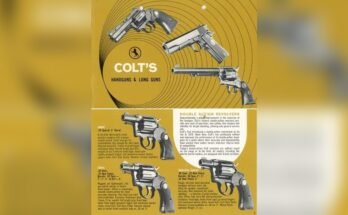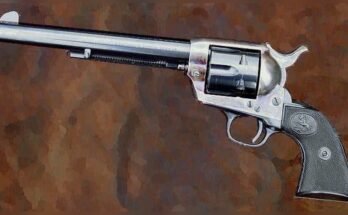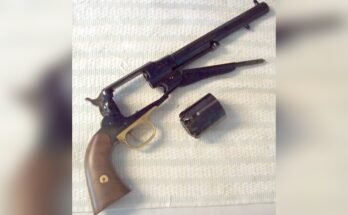If you own a single-action revolver or are thinking about handling one, knowing how to load it safely and correctly is key. You might think it’s complicated, but once you understand the simple steps, you’ll feel confident every time you pick up your revolver.
You’ll discover exactly how to load your single-action revolver quickly and safely. Keep reading to learn the easy method that will help you handle your firearm like a pro.

Safety First
Safety comes first when loading a single-action revolver. Handling any firearm demands full attention and care. A few simple steps can prevent accidents and keep you and others safe.
Check The Firearm Status
Always start by checking if the revolver is loaded or unloaded. Open the loading gate and rotate the cylinder to inspect each chamber. Make sure no bullets are present before proceeding. Keep the muzzle pointed in a safe direction at all times.
Clear Your Surroundings
Look around to ensure no people, pets, or objects are nearby. Choose a safe, open area with a stable surface to work on. Avoid distractions like phones or loud noises while handling the revolver. Clear surroundings reduce the risk of accidents.
Inspect The Revolver
Before loading a single-action revolver, inspect it carefully. This step keeps you safe and ensures the gun works well. A quick check helps avoid problems during shooting. Always handle the revolver with care and attention.
Examine The Cylinder
Open the cylinder fully. Look at each chamber closely. Check for dirt, rust, or damage. Make sure the cylinder moves smoothly when you turn it. A clean and well-functioning cylinder is important for safe loading and firing.
Look For Obstructions
Check every chamber for any blockages. Dirt, debris, or leftover bullets can cause jams or accidents. Use a light if needed to see inside clearly. Clear out anything unusual before loading your rounds. This step protects both the revolver and the user.
Open The Loading Gate
Start by swinging open the loading gate on the revolver’s side. This allows access to the cylinder chambers for loading each cartridge easily.
Start by finding the loading gate on the revolver’s side. This small hinged door lets you access the cylinder chambers. Opening it is simple but important for safe loading.
Hold the revolver firmly with one hand. Use your thumb or fingers to gently pull the loading gate open. You will hear a soft click as it swings out.
The gate reveals the cylinder chambers, where cartridges go. Make sure the cylinder is aligned so you can load each chamber easily. The open gate keeps the cylinder steady during loading.
Always check that the revolver is unloaded before opening the gate. Keep your finger off the trigger to avoid accidents. Opening the loading gate is the first step to load a single-action revolver safely.

Half-cock The Hammer
Half-cocking the hammer stops it between fully down and fully back. This position allows the cylinder to rotate freely for loading. Always ensure the hammer is securely half-cocked before placing bullets in the chambers.
What Does Half-cock The Hammer Mean?
Half-cocking the hammer is a key step in loading a single-action revolver. It means pulling the hammer back just enough to stop between fully down and fully back. This position allows the cylinder to rotate freely.
Without half-cocking, the cylinder stays locked and you cannot load the chambers. It also prevents the gun from firing accidentally while loading.
How To Set The Hammer At Half-cock
Hold the revolver firmly but safely. Slowly pull the hammer back until you feel it catch halfway. You should hear a small click or feel resistance. The hammer will stay in this position until you move it again.
Do not pull the hammer all the way back at this stage. Full cock is for firing, not loading.
Why Half-cocking Is Important For Safety
Half-cocking keeps the cylinder unlocked and the gun safe. It stops the hammer from resting on a live round. This reduces the risk of accidental discharge.
Always half-cock the hammer before opening the loading gate. It is the safest way to load a single-action revolver.
Eject Spent Cartridges
Removing spent cartridges from a single-action revolver is an important step. It keeps the gun ready for the next use. This process helps avoid jams and ensures smooth operation. Proper ejection also makes cleaning easier and safer.
Use The Ejector Rod
Locate the ejector rod below the barrel. Push it firmly to the rear. This action pushes out the spent cartridges. Do this one chamber at a time. Make sure each cartridge moves fully out of the cylinder. Avoid forcing the rod too hard to prevent damage.
Check Each Chamber
After using the ejector rod, look inside each chamber. Confirm no cartridges remain stuck. Use a flashlight if needed for better visibility. Clear any remaining cases by hand carefully. This step prevents misfires and keeps the revolver safe.
Load Fresh Cartridges
Loading fresh cartridges into a single-action revolver is a careful process. It helps keep the gun ready and safe to use. Using new cartridges ensures the best performance and reliability. Take your time and follow the right steps.
Insert One Round At A Time
Start by opening the loading gate on the revolver. Place one cartridge into the chamber. Push it gently but firmly until it fits completely. Repeat this step for each chamber. Inserting rounds one by one helps avoid jams or damage.
Ensure Proper Alignment
Check that each cartridge sits straight inside the chamber. Misaligned rounds can cause problems when firing. Align the cartridges so the bullet points forward and the primer faces backward. Close the loading gate carefully after loading. Proper alignment keeps the revolver safe and functional.
Close The Loading Gate
Closing the loading gate is a key step in loading a single-action revolver safely and correctly. This small door covers the cylinder chambers once you finish placing cartridges inside. It keeps the rounds secure and protects the mechanism from dirt or damage.
After loading each bullet into the chambers, gently swing the loading gate back into place. It should click softly, indicating it is fully closed. A properly closed gate helps ensure the revolver will function smoothly when fired.
Never force the gate shut. Forcing it can bend or break the hinge. Check that no cartridges block the gate from closing. Take your time and handle the firearm with care.
Check The Gate Alignment
Make sure the loading gate lines up perfectly with the cylinder. A misaligned gate can cause issues during shooting. Close it slowly and watch for any gaps or resistance.
Feel For A Secure Closure
The gate should stay firmly closed without wobbling. A loose gate might open unexpectedly. Press gently to confirm it is locked in place.
Inspect For Obstructions
Look inside the gate area before closing. Remove any dirt, debris, or cartridge cases that may block the gate. Clean parts if necessary for smooth operation.
Lower The Hammer
Lowering the hammer on a single-action revolver is a key step in loading it safely. This action prepares the revolver for opening and inserting cartridges. It also helps prevent accidental firing during the process.
Understanding how to lower the hammer correctly makes handling the revolver easier. It ensures the gun is in the right position for loading.
Check The Hammer Position
Start by looking at the hammer’s current position. The hammer should not be fully cocked back. If it is, pull it down gently until it rests near the frame.
Use A Soft Touch
Lower the hammer slowly with your thumb. Avoid letting it snap down. A soft touch keeps the mechanism safe and prevents damage.
Ensure The Cylinder Can Swing Out
With the hammer lowered, the cylinder can swing out freely. This allows easy access to the chambers for loading bullets.
Perform A Final Safety Check
Performing a final safety check is crucial before using a single-action revolver. It ensures the firearm is ready and safe to handle. Skipping this step can lead to accidents or malfunctions. This part of the process helps confirm that everything works as it should.
Verify Cylinder Rotation
Check the cylinder by pulling the hammer back slowly. The cylinder should rotate smoothly and click into place. This action lines up the chambers properly for each shot. If the cylinder sticks or does not turn, do not load the revolver. Fix any issues before proceeding.
Confirm No Obstructions
Look inside each chamber to ensure no debris or blockages exist. Use a flashlight or a small tool to inspect carefully. Obstructions can cause dangerous jams or misfires. Clear any dirt or objects before loading bullets.
Frequently Asked Questions
How Do You Safely Load A Single-action Revolver?
To safely load, first ensure the gun is pointed in a safe direction. Half-cock the hammer to unlock the cylinder. Rotate the cylinder to align chambers. Load each chamber with a cartridge carefully. Close the loading gate securely before use.
What Is The Correct Position To Load A Revolver?
The revolver should be half-cocked to allow the cylinder to rotate freely. This position disengages the hammer and aligns the chambers for loading. Always keep the firearm pointed away from yourself and others during this process.
Can You Load All Chambers In A Single-action Revolver?
Yes, but many shooters leave one chamber empty as a safety measure. This practice, called “loading six for five,” prevents accidental discharge if the hammer slips. Always follow manufacturer guidelines and safety protocols when loading all chambers.
Why Is The Loading Gate Important On A Revolver?
The loading gate protects the cylinder chambers and ensures cartridges stay securely in place. It also helps align the cylinder correctly when loading or unloading. Always close the loading gate fully to prevent dirt and debris from entering.
Conclusion
Loading a single-action revolver is simple once you know the steps. Take your time and follow each step carefully. Always keep safety first by pointing the gun in a safe direction. Practice makes the process easier and faster. Remember to check the cylinder before loading.
This helps avoid mistakes. Handling your revolver with care protects you and others. Enjoy your shooting experience safely and confidently.



